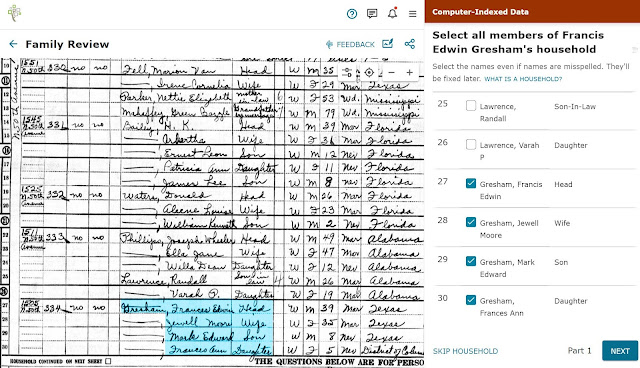The 1950 United States Census was released on April 1, and since then, I've been doing some indexing work (to make it searchable) at both the National Archives and Records Administration (NARA) site and at FamilySearch's community project site.
Machine-learning and artificial intelligence (AI) processes were used to create an initial index for both sites. The NARA site has a built-in transcription feature to allow you to correct and add names to the name index, which was available on April 1.
FamilySearch has been rolling out its index project state by state, as its partner Ancestry does its own machine-learning AI process to interpret handwriting. There are three steps: Name Review, Family Review, and Header Review.
In Name Review, you can pick an available state and then enter a surname you'd like to search for. I noticed a few days ago that Name Review was available for Florida, where my husband's family was living in 1950. So of course I searched for Gresham!
I worked through a few Gresham families that weren't mine, but in not too long, my Greshams showed up! The name review process was pretty easy. You basically marked the name as a match, edit it if the transcription was wrong, or you could also mark Unsure (if it was very unreadable, for example). "Not a Person" was used to mark lines with notes such as "vacant" or "not at home." "Transcription Error" is not used very often, but I had a case where the AI interpreted the first name as a surname, so I used it there.
Mark's family was pretty much correct. The enumerator has beautiful handwriting, and even included middle names (my mother-in-law Jewel did not have a middle name, so her maiden name of Moore is included). The enumerator did forget to dot the i in my father-in-law Francis' first name. This listing does create some questions, as I thought my father-in-law's middle name was Edward (a name used a lot in the family) and not Edwin. and I thought Jewel's name was spelled with one L. I transcribed those names as they appear, however, because that is what you are supposed to do in a transcription - write it as it is, don't make corrections.
A few days later, Florida was available for Family Review. In this process, you group households together, and also index all the answers to other questions asked of individuals on the census. Once again, I could search for Greshams, and eventually mine turned up.
The first step asked you to select all members of the household. The machine-learning AI attempted to do this based on information in the first four columns of the census page, but you could make corrections.
My Greshams were listed at the bottom of a census page, so I was also asked to look at the next page and see if any other household members were there. That wasn't the case (youngest sister June was not born until 1952), but here is what that next screen looks like anyway. Enumerators were supposed to check a box (visible in the image above) at the bottom of the previous page if the household continued onto the next page, but they did not always remember to do that.
The next question asked you to select the correct street name (in the far left column, usually written sideways) from those the machine-learning AI had identified. If the name was missing from the selections, you could click "Other" and add it. You could also make corrections to the street name if needed. In 1950, the Gresham family was living at 1505 N. 50th Avenue (in a house that apparently no longer exists) in Pensacola.
Next. the program zoomed in so you could add the house and apartment/unit number (if there were ones), and record the dwelling serial number as well as some answers to household questions. The enumerator was not supposed to repeat the street name on the apartment number line, so I left that out.
Next, you reviewed and made any corrections (to transcription errors) to the names and relationships. I did not have to make any changes in this section.
Then you reviewed race, gender, and current age. The AI was generally pretty good at getting these right. The exception was for children less than a year old, where the enumerator was to record the month of birth. Apparently the AI was expecting numbers and not text in this field, because it's almost always been wrong.
Then you reviewed marital status, birthplace (which was followed by a code), and naturalization status (if applicable). Mark and his parents were born in Texas; his sister was born in Washington, D.C. while the family was living in that area during World War II. The codes for the birthplaces often needed correction, because the AI usually interpreted a zero to be the capital letter O.
The next columns addressed work status. Not surprisingly, Francis (like most married younger men in that era) was working (the automatic assumption being outside the home), and Jewel (like most married younger women in that era) was housekeeping in the home. Other choices for question #15 were "Other" and "Unable to Work," the latter often the case with older people.
If the answer to the previous question was "Working," these next fields were completed. Francis worked 40 hours a week as a lithographic supervisor in civil service with the government (he supervised a print shop at the Pensacola Naval Air Station). The last three columns included additional codes. These almost always needed correction from what the AI saw, and often the AI saw something in fields that were empty!











Great overview of how the process works! TY.
ReplyDelete